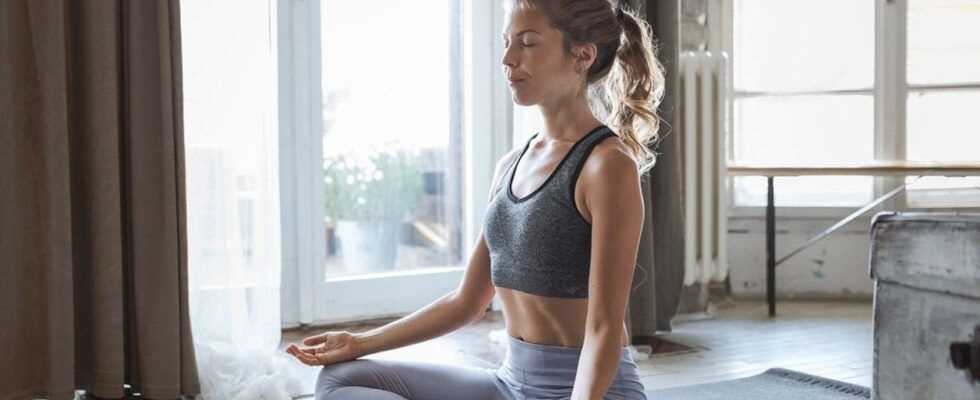What if breathing well could help us feel better? This is the whole principle of Pranayama, a technique that allows you to control your breath and thus contribute to our well-being.
Good breathing can be the solution to our many ailments. Controlled, it even becomes an ally for our health and well-being. This is what Nicole Bordeleau demonstrates in her book "How to breathe better": "Breathe well, nothing could be easier, but no one tells us. However, good breathing is essential to strengthen our health, stabilize our emotions, dissolve anxiety, find calm in ourselves and be freer internally."Yes, as many powers as we did not know until today! But discovering the unlimited potential of his breath actually has a name, it is called Pranayama.
What is Pranayama?
Our breath is of inestimable importance for our well-being, so it is useful to know how to control it. Because yes, deep, conscious breathing can change everything. This art of breathing is now better known as Pranayama, it is actually one of the eight pillars of yoga. It is indeed thanks to yoga that we generally learn to use our breath. Today, yogis also consider the breath prana as a therapeutic care tool. To better understand its definition, we can break the word down into two terms: prana, which is none other than life energy, and âyâma, which means "length", "extension", but also "control".
The benefits of Pranayama
Breathing well can change a life. In any case, it upset that of Nicole Bordeleau! "It is thanks to yoga that I learned to use my breath, whether to revitalize my body, declutter my mind, eliminate physical tensions, relieve pain, face fear, go through a moment of sorrow or a period of discouragement", the author tells us in her book. If a controlled breath makes you feel better in your body, breathing with your whole body can also be synonymous with rebirth.
Just like the waves have the power to set in motion the immensity of the ocean, the breath has the same potential to awaken life at the bottom of each of us.
Learning to breathe well is something you can learn. But once you master the right technique, "the breath deploys its many powers such as reviving the blood circulation, eliminating toxins, physical and mental tensions, helping to relieve or better live with pain, revitalizing a tired body and pacifying an agitated mind ."continues Nicole Bordeleau. Healing ailments through breathing is therefore accessible to all, provided you know how to put it into practice with the right exercises.
Pranayama in practice
Pranayama consists of several exercises that allow you to become aware of your respiratory movements and to stretch them.
- The alternating breathing technique or Nadi shodana
Nadi shodana reminds us of the importance of breathing through the nose. In particular, nasal breathing allows you to become more aware of your breath, by observing the air passing through the nostrils on inspiration and expiration. Before starting the exercise, make sure your nasal passages are clear and sit with your back straight.
– Using the right thumb, gently press on the hollow of the right nostril to close it.
– Inhale through the left nostril and at the end of inspiration, close the left nostril with the ring finger then release the right nostril.
– While keeping the left nostril closed, exhale slowly through the right nostril.
– While keeping the left nostril closed, inhale from the right nostril and once the lungs are full, plug the right nostril again with the thumb, release the left and then slowly and completely exhale through the left nostril.
- The victorious breath technique or Ujjayi
The victorious breath technique is deep breathing with concentration on the flow of breathing in the larynx. This exercise oxygenates the lungs, cleanses the respiratory system, tones the body and soothes. It is practiced in a seated position, legs crossed.
– Breathe in and out deeply through your mouth.
– Exhale with the back of the throat, slightly restricting the passage of air.
– Once you are comfortable with the exhalation, start applying the same throat tones when inhaling.
– When you are able to control the throat on both inspiration and expiration, close your mouth and start breathing through your nose.
- The technique of refreshing breathing or shitali
The technique of refreshing breathing or shitali is a yoga technique that refreshes the body and mind. Perfect in hot weather, it affects the areas of the brain responsible for temperature regulation. Like all other techniques, the shitali practice sitting.
– Roll the tongue into a tube.
– Inhale through the small tube formed by the tongue quietly, and breathe out peacefully through the nose.
– Repeat for 10 to 15 cycles minimum.
See also: Yoga postures to test with your child for a session at home
